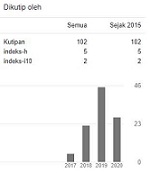THE IMPLEMENTATION OF TOTAL PHYSICAL RESPONSE (TPR) IN TEACHING ACCOUNTING INFORMATION SYSTEM AT ACOUNTING DEPARTMENT IN UNIVERSITAS MADURA
Abstract
In today's complex business environments, the quality of information management and information systems has become a key factor of success. This subject needs to use a variety of teaching and learning strategies to provide students with a hands-on approach to learning about accounting information systems. Lectures are interactive and are used to impart important theoretical and practical concepts. the writer formulates the questions as follows: (1) How to apply TPR Method in teaching Accounting Information Systems at Unira?, (2) What are the student’s response toward the implementation of TPR in teaching Accounting Information Systems at Unira? The researcher uses descriptive qualitative method to get the aim. There are one lecturer and 32 students so that the researcher tries to concentrate the subject of this research. Data of the research collected by Observation, Interview and Questioner.
Based on the analysis, it can be concluded that during learning process taking place in the class by using Total Physical Response (TPR) method was very good, the lecturer can apply the method well and the students can give good response to the material by using this method.
This is shown by their interaction in the class, usually they are not interested to study, but by applying this method can reduce the passive student to be active students, and they began to interest to study. Based on the result above can be described on the percentage of the student who fill the questioner that provided by the lecturer to measure the students interest, there for about 64.7% students are interested to study vocabulary by using TPR method because they can enjoy the material by using action, and only a few students are not interested to this method with several reason such as; they don’t have self-confident, even they misunderstanding to the material
Keywords
References
Bahri, Syaiful. 2018. Metodelogi Penelitian Bisnis. Yogyakarta. Andi offset. Darise Nurlan. 2006. Pengelolaan Keuangan Daerah. PT. Indeks IKAPI Bandung.
Creswell, W, John. 2005. Research Design: Qualitative, quantitative, and mixed method approaches- 2nd ed. USA: Sage Publication, Inc.
Daniel Pratt, D. Good Teaching: One Size Fits All?. New Directions for Adult and Continuing Education no. 93 (Spring 2002): 5-15. accessed on 9th February 2014
Fischer, Barbara Bree and Louis Fischer (1979). Styles in Teaching and Learning. Educational Leadership 36 (January), 251. accessed on 6th January 2014
Gelinas, U.J., Dull, R.B., (2014), Accounting Information Systems, 10th ed., Mason, Cengage Learning.Hall,
Grasha&Grasha (1996). Teaching with Style. Pittsburgh, PA: Alliance Publishers. accessed on 4th February 2014
Hadi, Sutrisno. 1987. Methodology research 2.Yogyakarta. Yayasan Pembina Fakultas Psikologi. Universitas Gajah Mada
Harmer, Jeremy. Harlow. 2008. How to teach English. U.K. Longman
J.A. (2016), Accounting Information Systems, 9th ed., Mason, Cengage Learning.Romney, M.B.; Steinbart, P. (2014), Accounting Information Systems, 13th ed., Upper Saddle River, Pearson
Pengantar, Mengajar kreatif siswa aktif. Jakarta. Rineka Cipta.Press.
Richardson, V, Chang, J. and Smith, R. (2014), Accounting Information Systems, New York, McGraw-Hill.
Simkin, M., Rose, J. and Norman, C. (2015), Core Concepts of Accounting Information Systems, 13th ed., Wiley &Sons.
Sunyoto, danang. 2013. Metodologi Peneltian Akumtansi. Bandung. PT. RefikaAditarma
Turner, L., Weickgenannt, A. (2013), Accounting Information Systems: The Processes and Controls, 2nd ed.,Hoboken, Wiley.
DOI: 10.53712/ellite.v2i2.871
Refbacks
- There are currently no refbacks.







